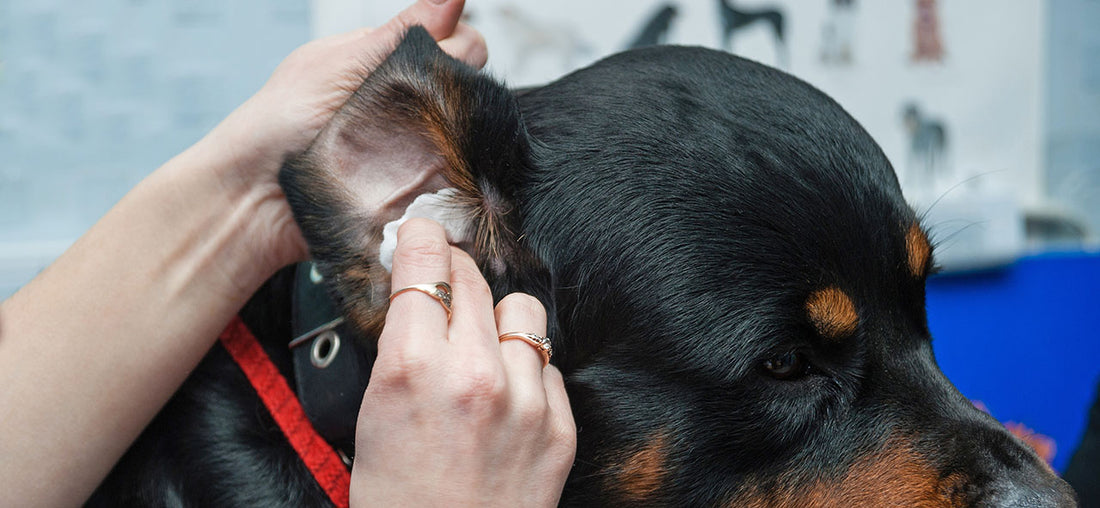Ear infections in dogs are very common and are a daily occurrence in veterinary practices. There are many different causes of ear infections, and there are also many different treatment options.
As is often the case, you cannot tar every ear infection with the same brush and each dog ear must be examined individually. However, one thing is clear: a good and natural cleaning of the ears is the be-all and end-all.
Ear infection – causes and factors
The causes of ear infections in dogs are very diverse and are divided into four factors:
- Predisposing factors
- Primary factors
- Secondary factors
- Perpetuating factors
It sounds complicated at first, but don’t worry… it’s not that difficult.
- Under predisposing factors refers to factors that promote ear infections but do not directly cause them. These include anatomical features such as narrow ear canals (e.g. Shar Pei) or poor ventilation due to drooping ears (e.g. Cocker Spaniel), but also climatic factors such as heat and moisture. Long- and fine-haired dogs also have more sebum and ear wax glands than short-haired dogs, which can lead to increased ear wax production and thus also promote ear infections.
- Primary factors are responsible for the development of ear infections. These include food and environmental allergies, atopic dermatitis, ear mites, hormonal disorders (e.g. hypothyroidism), autoimmune diseases, tumors or foreign bodies such as awns.
- As a result of primary factors, the secondary factors , which have a reinforcing effect. This leads to infections with bacteria or yeast fungi.
- The perpetuating factors prevent healing. They are the result of chronic ear infections. This can lead to middle ear infections, narrowing of the ear canal and the development of additional and larger sebaceous and earwax glands.
Simply summarized: These four factors could also be described as promoting, causing, aggravating and stopping factors.
This classification may seem complicated at first glance. However, it is very helpful in better understanding the extent of an ear infection and being able to treat it specifically.
Not all ear infections are the same
In fact, there is a division here too. A distinction is made between three types of ear infections:
- Inflammation of the external auditory canal (otitis externa)
- middle ear infection (otitis media)
- inner ear infection (otitis interna)
But one thing at a time. First, we will deal with the inflammation of the external auditory canal.
Symptoms: How do you recognize an external ear infection?
Shaking the head, itching, scratching, rubbing the head, tilting the head, swelling and redness of the auricle, warm ears, ear discharge, dark coatings and unpleasant odor: these can all be signs of an ear infection of the external auditory canal. that need to be acted upon .
In cases of more severe inflammation, the ears are often painful, which is why dogs no longer like to have their ears touched.They can react shyly or aggressively.
Inflammation of the external ear canal is very common. Dogs with long hair and heavy floppy ears are more often affected.
Ear infection in dogs – what to do?
If your dog has an ear infection, a visit to the vet is essential. The vet can examine the ears closely (otoscopy), notice any changes and identify any foreign bodies and ear mites. An ear swab can be used to accurately diagnose bacteria, yeast and mite infections.
Depending on the cause of the ear infection, treatment is often carried out with ear cleaners , anti-inflammatory ear drops, appropriate ear preparations against bacteria, yeasts or mites and other medications.
In some cases, ear rinsing and further treatment may be necessary.
It is particularly important to identify the actual cause of the ear infection and to act accordingly to eliminate it if possible. To get to the bottom of the matter, all four of the factors mentioned above should be taken into account.
Especially in the case of possible feed and/or environmental allergies (pollen, mites) very precise research into the causes should be carried out.
Middle ear infection in dogs
Inflammation of the external auditory canal or bacteria that enter the middle ear via blood or the throat can also cause inflammation in the middle ear.
In addition to the symptoms of inflammation of the external ear canal, pain when opening the mouth, fever and hearing loss can also occur. A middle ear infection also manifests itself through insufficient tear production and dry eyes.
In addition to the usual treatment for an ear infection, further treatment may include X-rays and CT/MRI, but also surgery may be necessary.
After the middle ear infection comes the inner ear infection
A middle ear infection can spread to the inner ear and lead to an inner ear infection, which can cause serious damage to the nerves. Fortunately, this type of ear infection is quite rare.
In addition to the symptoms already mentioned, other symptoms of inner ear infection include balance problems, unsteady gait, eye tremors and dilated pupils.
Here, too, an X-ray or CT/MTR may be necessary.

Ear infection – prevention
Basically, dog ears have a natural self-cleaning mechanism, so excessive care often has the opposite effect. However, if your dog has recurring problems with ear infections, you should keep a close eye on their ears.
1. Regular ear checks : Check your dog's ears regularly for dirt, redness, foreign bodies, unusual odors, or signs of parasites. As a precaution, you should also always take a look in the ears during vet visits.
2. Keep your ears clean : Dirt in the outer ear area of your dog can be gently wiped off. For example, the Lauscher-Auf ear cleaner However, you should leave the depths of the dog's ear alone and cotton swabs have no place in the dog's ear either.
3. Keep your ears dry : Dry your dog's ears thoroughly after bathing or swimming.Moisture in the ear can promote inflammation.
4. Trim hair in the ear area : If the ear's ability to clean itself is hindered by too much hair, plucking the hair can be helpful. However, this should not always be done as a preventative measure, but should be considered on an individual basis.
5. Nutrition and Allergies : Since ear infections in dogs are often caused by food allergies, feeding should be adapted to the individual. If allergies are suspected, an elimination diet should be used.
Ear infection in dogs - Conclusion
Ear infections in dogs are a common but generally easily treatable disease. With an early diagnosis, finding and eliminating the cause and individual veterinary treatment, a quick and uncomplicated healing is possible.
We at alphazoo will support you and your pet immediately with this problem. Test our natural ear cleaner and our gentle ear mite oil still today. Listen up!






















